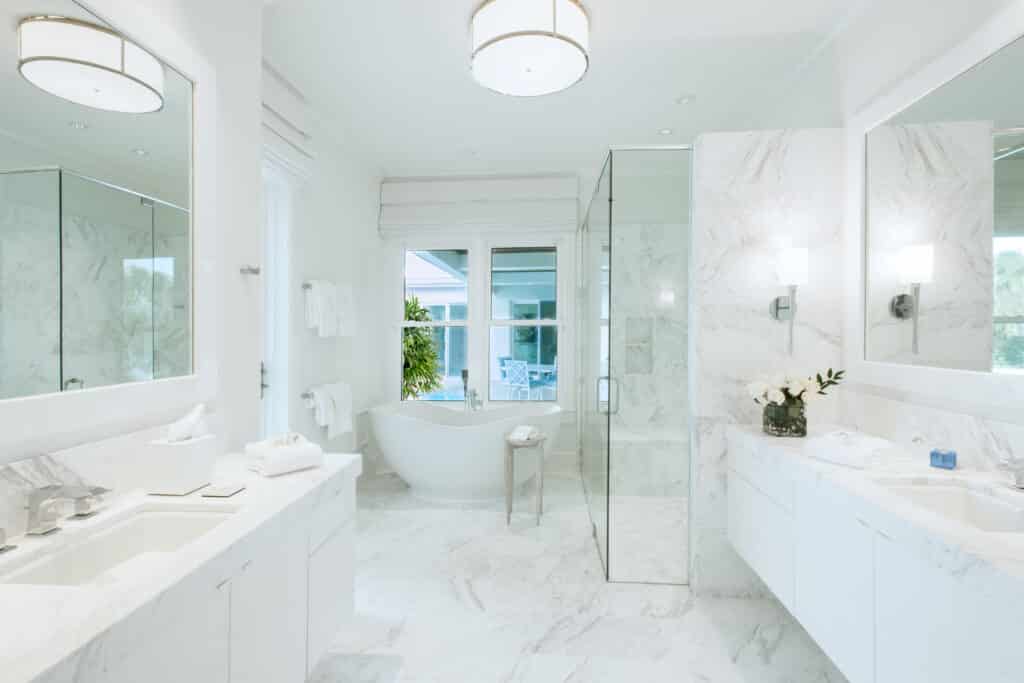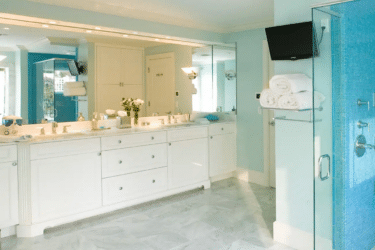Welcome to part two of Vertica| | Design + Build’s Home Maintenance To-Do Twice A Year series. Your house is more than just a house, it is a home that you share with your family and friends. A safe place that offers comfort, right? We realize how important your home is to you. Here we will share some maintenance tips that allow you to concentrate on the interior of your home.
Interior Home Maintenance Tips
Maintaining Wall Finishes – When you are expecting drywall, check for cracks at the windows, doors, corners, and ceilings.
- Inspect your walls for cracks. Cracks can occur after a heating or cooling season. Most issues can generally be repaired with two to three coats of joint compound, sand, and a new coat of paint.
- If you have textured walls, consult with a drywall contractor to retexture, as necessary.
- As far as paint or stains go you can look for peeling, cracking, blistering, fading, or scuff marks. It is best to scrape off paint from any damaged areas. Flat paint can be touched-up with a small brush and matching paint.
- Semi-gloss and gloss paint can be touched-up or wiped off with a damp sponge.
- Most stains can be rejuvenated with a good quality furniture polish.
- For wallpaper, look for loose or curling seams. Humidity can cause seams to separate. The wallpaper can be reattached with a compatible wallpaper seam adhesive.
- When inspecting brick or stone veneer, check them for cracks in the mortar. Changes in humidity may cause mortar to shrink. Consult with a qualified mason, as necessary, to repoint cracks and match existing mortar.
Cleaning Your Walls
1. Some painted surfaces may be cleaned with a mild solution of detergent and water. If you are not sure of how the paint will react to cleaning, try washing in an inconspicuous place.
2. Glazed brick or tile should be washed with soap and water. Use a non-abrasive household cleaner to remove any stains.
3. Wood paneling can be cleaned with a wood cleaning product and then treated with paneling wax or with linseed oil.
Cabinets & Countertops – Kitchens and bathrooms are considered to be high-traffic areas in the home.
- It is a good idea to inspect the hardware on all cabinets. Adjust, tighten or lubricate knobs, hinges, latches, rollers, and drawer glides as needed.
- Refresh varnished wood cabinets with a quality furniture polish once a month.
- Avoid using a paraffin-based spray wax.
- For painted cabinets, you can clean them with a mild non-abrasive detergent on a damp sponge.
- You can fill in any scratches with a matching touch-up crayon available at most hardware stores.
- Real wood cabinets should be cleaned and waxed just like fine furniture.
- With plastic-coated cabinets, you can clean them with a detergent solution.
- Laminate countertops, and inspect to see if the caulking joints are in good condition and well-adhered to both sides of the joint.
- Avoid placing any hot items such as pots, pans, and irons on laminate countertops. The heat can liquefy the underlying glue.
- Never cut directly on your countertops – always use a cutting board.
- Avoid prolonged exposure of dishwasher steam to the underside of the countertop – high humidity and condensation may cause the wood to warp under the laminate.
- For ceramic tile countertops, inspect the grout and tile for cracks. Replace any cracked tiles and re-grout as necessary. White grout can be refreshed by applying a diluted bleach solution with a stiff narrow brush.
Foundation or Crawl Space
Slab-on-grade foundations, walk the entire ground floor, and look for any water stains or cracks in the concrete.
- Remove the stains with an appropriate concrete cleaning agent.
- Seal any cracks that may allow water to enter with a compatible waterproof caulk.
For your crawl space foundations.
- Inspect the concrete or cinder block walls. Look for any water stains or cracks. Seal any cracks that may allow water to enter with a compatible waterproof caulk.
- Check the ground surface for any standing water.
- Inspect the sump pit if applicable. If there is water in the pit, verify that the sump pump is operational by pouring additional water into the pit to trigger the pump, or install a pump if it is absent. Locate all air vents. Verify that your air vents are open and unobstructed by insulation or any other debris.
Main Service Panel, Circuit Breakers, GFCI Outlets & Breakers – Look for any rust, water stains, soot stains, or melted wires.
- Check your circuit breakers. Ensure that they are properly labeled. Do a quick check to verify that the labeled circuit is actually the correct circuit by switching off the breaker and trying some of the devices connected to that circuit. If it’s not correctly labeled, re-label it and investigate the remaining circuits. Circuit breakers have three positions: “ON”, “OFF”, and “tripped”. They are designed to allow only a certain amount of electrical current to pass through the wires, usually in the range of 15 to 20 Amps. Circuit breakers will trip, or shut down if that amount of current is exceeded. If any breakers are tripped, switch them to “OFF” then back to “ON”. If the breaker trips again, unplug all devices on that circuit. If this corrects the problem, then there are too many devices plugged into this circuit or one of the devices or the cords is faulty, unsafe, and leaking electrical current. If the breaker continues to trip, consult with a qualified electrician as necessary.
- GFCI outlets and breakers. These outlets and switches have both “TEST” and “RESET” buttons on them that are ultra-current sensitive to protect you from accidental electrocution if you’re exposed to water and an electrical device. They are usually found in kitchens, bathrooms, garages, basements, and in the main service panel. Push the “TEST” button at least once a month to trip the circuit. If the “RESET” button doesn’t pop outward during this test, consult with a qualified electrician. If it does pop out, push it back in and repeat next month. Do not plug refrigerators or freezers into a GFCI circuit. These appliances experience sudden large power draws which can trip the GFCI switch and spoil your food.
Troubleshooting Electrical Issues & Prevention
If for any reason an electrical outlet doesn’t work, see if it’s controlled by a switch, GFCI switch, or if the breaker has tripped, before calling an electrician. Don’t use light bulbs with a higher wattage than the fixture allows. Never overload extension cords or use too many when bringing power to a remote device or fixture – check the label for any restrictions. Plug your sensitive electronic devices such as televisions, computers, printers, VCRs, etc. into the appropriate surge protector strips. Unplug them during lightning storms. If there are small children in the home, install outlet protector guards to keep out little fingers and paper clips.

Sinks, Tubs & Showers – Inspect and replace caulking and the grout around tubs, showers, and sinks as needed.
- For your sinks, turn on the hot and cold water and observe the water pressure and drainage to ensure both are adequate. If the water pressure is low, unscrew the piece (aerator) at the end of the spigot and inspect the filter screen. Wash out any trapped pieces of debris, then reinstall.
- If the sink is slow to drain, you can try some drain cleaner to see if that helps, but use a funnel when pouring to avoid splashing acid on the basin surface. Drain cleaners should NOT be used if your home is on a septic system. Another alternative to clear a drain would be to disassemble the trap (“U”-shaped pipe) under the sink to try and clear any obstruction. Put a bucket under the trap first since it usually contains a small amount of water. This also works well for fishing out small valuables that go down the drain.
- To clean your sink’s surfaces, use a non-abrasive cleanser and warm water on a damp sponge.
- For your bathtubs and showers, operate the cold and hot water and check for adequate water pressure and drainage. If you notice low water pressure in your shower, unscrew the shower head and flush it out, against the direction of normal flow, to clear any debris. A rubber plunger can usually unclog any drain obstructions. If that doesn’t work, you can try some drain cleaner to see if that helps, but again, use a funnel when pouring to avoid splashing acid on the tub or shower surface.
- When you are cleaning surfaces, use a non-abrasive cleanser and warm water on a damp sponge. Use a brass cleaner on solid brass fixtures – not coated brass.
- For toilets, clean often using a non-abrasive cleanser. Avoid scrubbing the bowl too hard with a toilet brush. Bristle rod may scratch the porcelain. Avoid using drop-in type cleaners. Never mix cleaners, especially those containing bleach. If the toilet clogs and begins to overflow, turn off the water supply at the shut-off valve near the floor. Use a rubber plunger or something called a “coil spring auger” to clear any clogs. If the toilet runs constantly, try adjusting the float mechanism in the tank to shut off fill water sooner.
- Never flush baby wipes, sanitary napkins, dental floss, hair, grease, motor oil, paper towels or cups, diapers, small dead pets, etc.
- Condensation on the outside of the tank is not a leak. You can cover the tank with a tank cover if desired.
- For spas or jetted tubs, see “bathtubs” above for cleaning suggestions. To avoid motor damage, never operate jets unless outlet ports are covered by at least three inches of water. If jets don’t work, check to see if the GFCI outlet switch is tripped in the tub equipment housing area.
Last but definitely not least, heating and cooling your home. Especially in Florida, you are going to want to be sure you are keeping up with your HVAC maintenance. It is important to have your HVAC system serviced once a year.
Heating & Air Conditioning – Complete seasonal maintenance on heating and air conditioning by a licensed HVAC contractor.
During the warmer months:
- Check the general condition of the compressor. Remove any debris as necessary.
- For air conditioners, turn on the system only when the outside air temperature is greater than 60 degrees Fahrenheit. Set the thermostat to the desired temperature or to a temperature slightly higher than normal if you are away from home during the day. (This will allow for quicker cooling to your desired temperature at night rather than trying to cool a hot house.) If the air conditioner does not operate, check the thermostat is set to the “COOL” setting. If that doesn’t help, check the circuit breakers. There are two: one which controls the compressor and one which controls the fan. Verify that both are in the “ON” position. If either is tripped, switch it to the “OFF” position and then to the “ON” position. If that doesn’t work, call a qualified HVAC contractor for assistance as necessary.
- If the system is operating properly, ensure that the condensation drain tube is draining water and is unobstructed. (It’s usually a clear plastic tube located next to the heat pump which drains into a floor drain or to the outside.) Verify that the outside compressor unit operates free and clear of any debris and don’t forget to remove any protective cover left on the unit over the winter.
- When it is hot outside, be sure to shield the inside of your home from direct sunlight and the outside air. Radiation from the sun will heat your walls, floors, and furniture.
- Consider installing ceiling fans where desirable. They help with air circulation and enable the system to operate more efficiently.
- Make sure all cooling and return air vents are clean, clear, and unobstructed. Set air vent vanes upward on lower floors and slightly downward on upper floors. Air blowing from the vents should be noticeably cool. If not, there may be a refrigerant leak somewhere. Again, consult with a qualified HVAC contractor as necessary.
During the cooler months:
- For a heat pump or a natural gas furnace, turn on the system. (Heat pumps should not be operated unless the outside air temperature is below 65 degrees Fahrenheit.) Set the thermostat at the desired temperature. If the system does not operate properly, check to see that the thermostat is set to the “HEAT” setting. Also, check that the fan panel on the furnace unit is secure. (There is a switch behind the panel which will keep the furnace from operating if the panel is loose.) If that doesn’t work, check the circuit breakers. Verify that the breakers are in the “ON” position. If any breakers relating to the fan or compressor are tripped, switch them to the “OFF” position and then to the “ON” position. Otherwise, consult with a qualified HVAC contractor for assistance as necessary.
- If the system is operating properly, confirm that noticeably warm air is blowing out of the air vents. A mild odor is common the first time you turn on the heat and should dissipate shortly.
- Also, check that any auxiliary heaters are operational (heat pump). If you have natural gas heat and smell a strong odor of gas, leave the home immediately and call the gas company from a neighbor’s house. Do not turn on the lights or use the telephone. If your furnace has a pilot light, there will be re-lighting instructions on one of the inside panels for reference in the event it ever goes out.
- Make sure that the fresh air duct near a natural gas unit is open and unobstructed.
- Occasionally, heat pumps will activate a defrost cycle which will melt ice buildup on the internal coils of the outside unit. When this occurs, steam will be seen rising from the unit. This is normal and not cause for concern.
- When it is cold outside, be sure to allow direct sunlight in whenever possible. Radiation from the sun will heat your walls, floors, and furniture and aid the heating system. Consider installing ceiling fans where desirable. They help with air circulation and enable the system to operate more efficiently.
- Make sure all heating and return air vents are clean, clear, and unobstructed. Set the air vent vanes slightly downward on lower floors and upward on upper floors.
HVAC Filters
Check the filter regularly on any heating or cooling system. Dirty filters result in reduced efficiency and higher operating cost. If your system has a disposable filter, you should replace it at least every other month during the heating season (all year if you have air-conditioning). If you experience periods of heavy use, high traffic in and out of the home, or other environmental conditions may necessitate more frequent replacement. Verify that the filter arrow points in the direction of airflow. Buy filters in large quantities for the sake of convenience. Permanent filters may be vacuumed or tapped to loosen dirt, then washed with warm water or mild detergent.
This concludes our series of Home Maintenance Tips with Vertical | Design + Build. We hope that you have found this information to be helpful!




